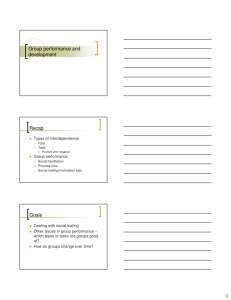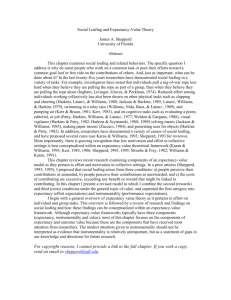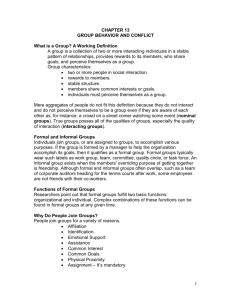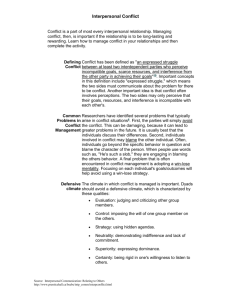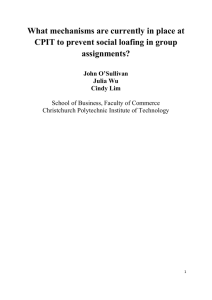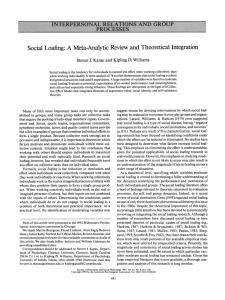Interpersonal Compatibility and Social Loafing: An Introduction to a
advertisement
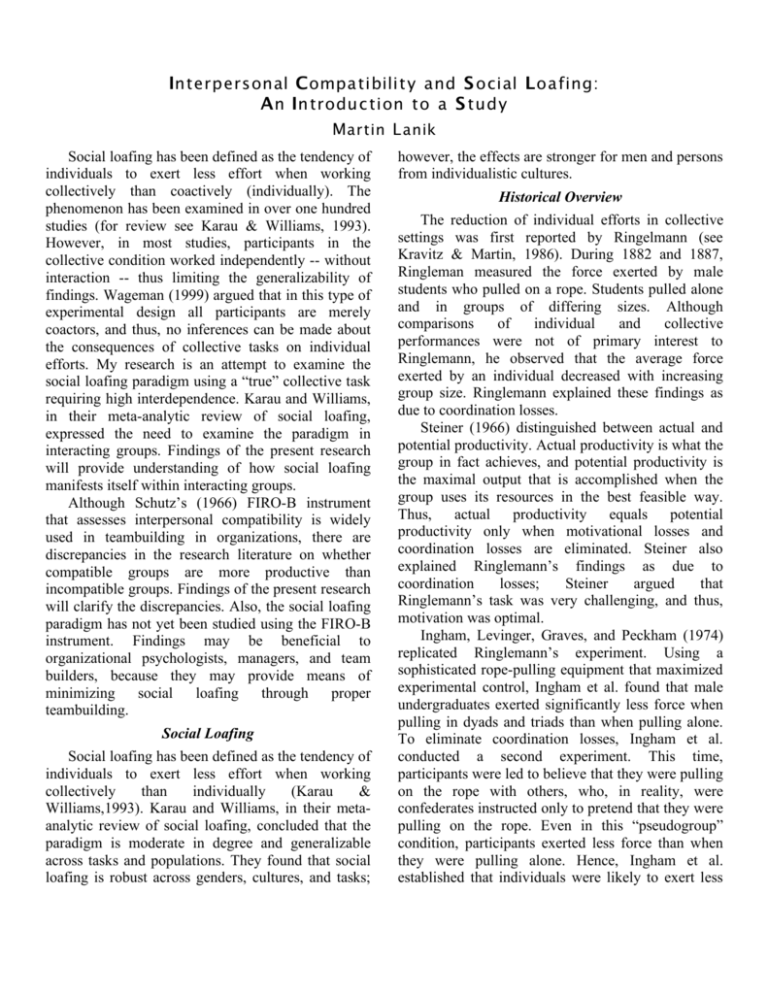
In terpersonal C ompa tibilit y and S ocial L oafing: A n I n trodu c tion to a S tudy M artin L anik Social loafing has been defined as the tendency of individuals to exert less effort when working collectively than coactively (individually). The phenomenon has been examined in over one hundred studies (for review see Karau & Williams, 1993). However, in most studies, participants in the collective condition worked independently -- without interaction -- thus limiting the generalizability of findings. Wageman (1999) argued that in this type of experimental design all participants are merely coactors, and thus, no inferences can be made about the consequences of collective tasks on individual efforts. My research is an attempt to examine the social loafing paradigm using a “true” collective task requiring high interdependence. Karau and Williams, in their meta-analytic review of social loafing, expressed the need to examine the paradigm in interacting groups. Findings of the present research will provide understanding of how social loafing manifests itself within interacting groups. Although Schutz’s (1966) FIRO-B instrument that assesses interpersonal compatibility is widely used in teambuilding in organizations, there are discrepancies in the research literature on whether compatible groups are more productive than incompatible groups. Findings of the present research will clarify the discrepancies. Also, the social loafing paradigm has not yet been studied using the FIRO-B instrument. Findings may be beneficial to organizational psychologists, managers, and team builders, because they may provide means of minimizing social loafing through proper teambuilding. Social Loafing Social loafing has been defined as the tendency of individuals to exert less effort when working collectively than individually (Karau & Williams,1993). Karau and Williams, in their metaanalytic review of social loafing, concluded that the paradigm is moderate in degree and generalizable across tasks and populations. They found that social loafing is robust across genders, cultures, and tasks; however, the effects are stronger for men and persons from individualistic cultures. Historical Overview The reduction of individual efforts in collective settings was first reported by Ringelmann (see Kravitz & Martin, 1986). During 1882 and 1887, Ringleman measured the force exerted by male students who pulled on a rope. Students pulled alone and in groups of differing sizes. Although comparisons of individual and collective performances were not of primary interest to Ringlemann, he observed that the average force exerted by an individual decreased with increasing group size. Ringlemann explained these findings as due to coordination losses. Steiner (1966) distinguished between actual and potential productivity. Actual productivity is what the group in fact achieves, and potential productivity is the maximal output that is accomplished when the group uses its resources in the best feasible way. Thus, actual productivity equals potential productivity only when motivational losses and coordination losses are eliminated. Steiner also explained Ringlemann’s findings as due to coordination losses; Steiner argued that Ringlemann’s task was very challenging, and thus, motivation was optimal. Ingham, Levinger, Graves, and Peckham (1974) replicated Ringlemann’s experiment. Using a sophisticated rope-pulling equipment that maximized experimental control, Ingham et al. found that male undergraduates exerted significantly less force when pulling in dyads and triads than when pulling alone. To eliminate coordination losses, Ingham et al. conducted a second experiment. This time, participants were led to believe that they were pulling on the rope with others, who, in reality, were confederates instructed only to pretend that they were pulling on the rope. Even in this “pseudogroup” condition, participants exerted less force than when they were pulling alone. Hence, Ingham et al. established that individuals were likely to exert less effort on collective than individual tasks due to motivational losses. Theoretical Explanations Social Impact Theory. Latane, Williams, and Harkins (1979) explained social loafing through the Social Impact Theory. The theory asserts that the magnitude of social influence is a function of number, immediacy, and strength of sources of social influence as they relate to targets. Magnitude of social influence decreases from individual to collective conditions in the social loafing research. Thus, participants in collective conditions feel less pressured to work hard, and their outputs are lower than of those working individually. Arousal reduction and identifiability. Williams, Harkins, and Latane (1981) suggested that, in social loafing, presence of others reduces arousal. Participants in collective conditions are not identifiable, thus their evaluation apprehension is minimal. Lower evaluation apprehension leads to lower arousal and may manifest itself in diminished productivity. Williams et al. supported this argument with two experiments in which male undergraduates shouted and clapped alone and in groups with varying levels of identifiability. As predicted, participants who were always identifiable exerted the same amount of effort in individual and group conditions. Evaluation potential. Harkins and Jackson (1985) argued that individuals engage in social loafing because, in collective conditions, they cannot obtain rewards or punishments for their output. Participants generated uses of an object in either identifiable or unidentifiable conditions. Participants were told that they were generating uses for either the same or a different object than the other group. Harkins and Jackson found that when participants’ performance was identifiable and comparable, they performed better than participants in all other conditions. Thus, Harkins and Jackson concluded that motivation could stem from people’s awareness that their performance can be compared. Harkins and Szymanski (1988) found that the chance of comparing one’s output with an objective criterion was sufficient in reducing social loafing. They identified two elements that were essential for self-evaluation: information about the output and information about the criterion. During a vigilance task, participants were either evaluated by the experimenter or not, were either provided with performance feedback or not, and were either provided with an objective criterion or not. The Collective Effort Model Karau and Williams (1993) suggested that theoretical explanations of social loafing preceding the Collective Effort Model were limited, in that each explained and provided predictions of the phenomenon within a restricted area. Thus, Karau and Williams argued for the need of a unified model of individuals’ efforts in collective settings, and they developed the Collective Effort Model to fulfill this requirement. The Collective Effort Model (Karau & Williams, 1993) asserts that individual performance is influenced by perceptions of associations between individual efforts and expected outcomes. Thus, individuals engage in social loafing because they perceive higher relationship between their efforts and valued outcomes in coactive (individual) conditions than collective conditions, where valued outcomes are split among all group members. On the other hand, individuals will work hard in collective settings only if they perceive their efforts to be instrumental in attaining personally valued outcomes. Individual effort leads to individual performance, which must influence group performance; group performance must lead to group outcome that is valued by the individual, and group outcome must relate to personally valued individual outcome. Individual outcomes include salaries, self-assessment information, and feelings of belonging. The Collective Effort Model assumes that persons either deliberately or subconsciously choose the extent of effort they will exert. Fundamental Interpersonal Relations Orientation Perhaps the most influential model of human interpersonal behavior is Schutz’s (1966) Fundamental Interpersonal Relations Orientation (FIRO) theory. Schutz identified three interpersonal needs that all humans possess to a larger or smaller extent. By “interpersonal”, Schutz means the relationship between interacting humans. Schutz argued that humans behave differently when they are in collective settings than when they are alone. The term “need” depicts the requirement that an individual seeks to meet. Not fulfilling this requirement creates negative consequences. Thus, an interpersonal need refers to a requirement that can only be fulfilled through interactions with other people. Inclusion need. According to Schutz (1966), the inclusion need refers to the internal urge to develop and preserve a desirable relationship with others with regards to interaction and connection. This need includes feelings of belongingness, acceptance, and significance. On the behavioral level, the inclusion need exhibits itself as wanting and giving attention. Affection need. Schutz (1966) defined the affection need as the internal urge to develop and preserve a desirable relationship with others with regards to love and affection. This need includes feelings of closeness and that one is loveable. On the behavioral level, the affection need exhibits itself as wanting to be close and personal with people, and wanting to make people feel cared for and cherished. Control need. The control need refers to the internal urge to develop and preserve a desirable relationship with others with regards to control and domination (Schutz, 1966). This need includes feelings of dominance, dependability, competence, and respect. On the behavioral level, the control need is related to the decision-making process. Individuals manifesting high need for control crave for authority, power, and domination over others. They want to make rules, lead, and influence people. On the other hand, individuals manifesting low need for control desire dependency and submission. Interpersonal Compatibility Interpersonal compatibility refers to the degree individual group members fulfill each others’ needs (Schutz, 1966). In a compatible group, individual group members satisfy one another’s needs. For example, if person A desires to be controlled, and person B desires to control, we would judge them to be compatible. However, if both persons A and B desired to control, but both loathed being controlled, we would judge them to be incompatible. On this view, incompatible groups are those in which individual group members do not satisfy one another’s needs. Reciprocal and originator compatibilities. Schutz (1966) stated that both reciprocal and originator compatibilities assess the degree to which individuals in dyads complement each other on the want-express levels. If one person expresses the behaviors wanted by the other, and if one person wants the behaviors expressed by the other, they are compatible. However, if one expresses behaviors not wanted by the other, and one wants behaviors not expressed by the other, they are incompatible. Interchange compatibility. According to Schutz (1966), interchange compatibility refers to overall group atmosphere in a particular need area disregarding the want and express levels. It is the extent to which all group members agree or disagree on the amount of inclusion, affection, and control they desire in their group. With regards to the control need, high interchange refers to the inclination to control and influence others, and being controlled and influenced by others. Low interchange, on the other hand, refers to the inclination not to control and influence others, and not being controlled and influenced by others. Interpersonal Compatibility and Group Productivity Several studies supported Schutz’s (1966) argument that compatible groups outperform incompatible groups (Downs & Pickett, 1977; Moos & Speisman, 1962; Reddy & Byrnes, 1972; Shalinsky, 1969). Schutz supported this argument by an experiment, in which participants in compatible groups outperformed participants in incompatible groups on three plotting tasks. Reddy and Byrnes studied the population of middle managers. Participants, assigned to groups of 10 to 12 based on their interchange compatibility in all three areas, completed the Lego Man. Each participant received equal amount of Lego blocks, and a finished figure was provided for reference. Reddy and Byrnes measured the speed of task completion, and the group that completed the task the fastest was pronounced the winner. In Shalinsky’s (1969) experiment, groups of children ages 9.5 to 12 competed in jigsaw puzzle and singing marathon during a three week camp. Groups were composed based on interchangecompatibility scores in the area of affection; additionally, Shalinsky computed reciprocalcompatibility scores in the area of affection for every dyad in a group. Moos and Speisman (1962) assigned college undergraduates into dyads based on their reciprocal and role compatibilities in the area of control. Participants moved rings from one peg to the other in a defined fashion. Each member of a dyad was assigned a role; the leader instructed the follower. Downs and Pickett (1977) constructed compatible groups, so that group members’ interchangecompatibility scores agreed in at least two need areas. They identified three types of groups: low-affection compatible, high-affection compatible, and incompatible. Each group member read an article and was tested on its content. The group was tested on the content of all articles to assess its productivity and usage of resources. Interestingly, only the lowaffection compatible groups outperformed the incompatible groups. Other studies (Hill, 1975; Shaw & Webb, 1982) failed to support Schultz’s (1966) prediction about the positive relationship between group compatibility and productivity. Shaw and Webb did not compose compatible or incompatible groups; instead, they assessed groups’ compatibility after the completion of the task. Student participants performed class related learning tasks in groups, and the study was conducted as a part of the course. Thus, insufficient experimental control and questionable task and productivity assessments might have accounted for Shaw and Webb’s findings. Similarly, Hill did not create compatible or incompatible groups; instead, Hill assessed the degree of compatibility of already existing teams. Productivity was measured by using comparative judgments of individuals that were members in two groups, and the task required only low levels of interdependence. Because both studies were executed in the field, it can be concluded that Schutz’s hypothesis lacks support in the natural setting. Focus of the Present Study The current study builds on the foundation provided by the Collective Effort Model (Karau & Williams, 1993) and Shutz’s (1966) FIRO theory of interpersonal needs. The Collective Effort Model suggests that individuals will work hard in collective settings only if they perceive their efforts to be instrumental in attaining personally valued outcomes. Schutz stated that individuals strive to fulfill their interpersonal needs in interacting groups. It seems reasonable to argue that interpersonal needs may at least partially translate into valued outcomes. Thus, persons will work hard in interacting collective settings only to the extent that they perceive their efforts to be instrumental in fulfilling their interpersonal needs and attaining other valued outcomes. Compatible and incompatible groups of three participants will be constructed based on Schutz’s (1966) interchange compatibility in the area of affection. In line with the social loafing research, participants will be led to believe that the study examines individual performances of people in groups (identifiable condition), or that the study examines performances of groups (unidentifiable condition). However, contrary to most social loafing research, participants in both unidentifiable and identifiable conditions will interact with their group members, and complete the task as a group. Groups of participants will be instructed to put together a jigsaw puzzle. Each participant will receive a complete set of pieces to the puzzle, and each set will be marked to enable assessment of individual contributions to the group task. Individual performance will be assessed by counting the number of pieces each member contributed to the largest piece of puzzle completed by the group. Because interaction will be constant among the unidentifiable and identifiable conditions, possible coordination losses should be the same in the two conditions. On this hypothesis, any individual decrements in effort can be attributed to motivational losses (see Steiner, 1966). References Downs, C. W., & Pickett, T. (1977). An analysis of the effects of nine leadership-group compatibility contingencies upon productivity and member satisfaction. Communication Monographs, 44(3), 220-230. Harkins, S. G., & Jackson, J. M. (1985). The role of evaluation in eliminating social loafing. Personality and Social Psychology Bulletin, 11(4), 457-465. Harkins, S. G., & Szymanski, K. (1988). Social loafing and self-evaluation with an objective standard. Journal of Experimental Social Psychology, 24(4), 354-365. Hill, R. E. (1975). Interpersonal compatibility and workgroup performance. Journal of Applied Behavioral Science, 11(2), 210-219. Ingham, A. G., Levinger, G., Graves, J., & Peckham, V. (1974). The Ringelmann effect: Studies of group size and group performance. Journal of Experimental Social Psychology, 10(4), 371-384. Karau S. J., & Williams, K. D. (1993). Social loafing: A meta-analytic review and theoretical integration. Journal of Personality and Social Psychology, 45(4), 681-706. Kravitz, D. A., & Martin, B. (1986). Ringelmann rediscovered: The original article. Journal of Personality and Social Psychology, 50(5), 936-941. Latane, B., Williams, K., & Harkins, S. (1979). Many hands make light the work: The causes and consequences of social loafing. Journal of Personality and Social Psychology, 37(6), 822-832. Moos, R. H., & Speisman, J. C. (1962). Group compatibility and productivity. Journal of Abnormal and Social Psychology, 65(3), 190196. Reddy, W. B., & Byrnes, A. (1972). Effects of interpersonal group composition on the problem-solving behavior of middle managers. Journal of Applied Psychology, 56(6), 516-517. Schutz, W. C. (1966). The interpersonal underworld. Palo Alto, CA: Science & Behavior Books. Shalinsky, W. (1969). Group composition as a factor in assembly effects. Human Relations, 22(5), 457-464. Shaw, M. E., & Webb, J. N. (1982). When compatibility interferes with group effectiveness. Small Group Behavior, 13(4), 555-564. Steiner, I. D. (1966). Models for inferring relationships between group size and potential group productivity. Behavioral Science, 11(4), 273283. Wageman, R. (1999). Task design, outcome interdependence, and individual differences: Their joint effects on effort in task-performing teams (Commentary on Huguet et al., 1999) [Electronic version]. Group Dynamics, 3(2), 132-137. Williams, K., Harkins, S. G., & Latane, B. (1981). Identifiability as a deterrent to social loafing: Two cheering experiments. Journal of Personality and Social Psychology, 40(2), 303-311.
